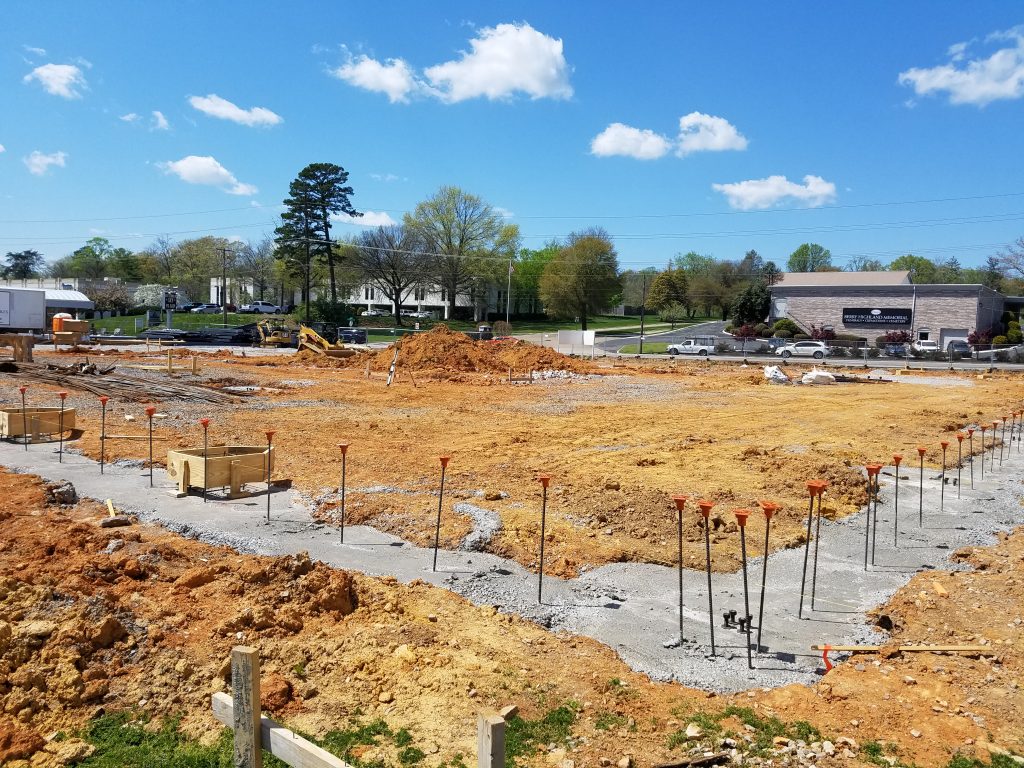I found this interesting video from the on how sinkholes form. The Tech Insider UK video below is a brief excerpt from a more detailed video at the Practical Engineering YouTube channel: https://youtu.be/e-DVIQPqS8E
Small Hydroelectric Stations
Clean energy is a buzz word we hear a lot, with hydroelectricity playing a big role in the delivery of clean, sustainable energy. However, there are environmental and financial concerns with the construction of new dams needed to produce hydroelectricity, especially in remote regions with small waterways.
Turbulent (http://www.turbulent.be/old-home) is a firm in Belgium that is manufacturing small, decentralized micro-hydropower plants, with features such as: fish friendly, low maintenance, suitable for low-head waterways, and no flood risks.
Below is a video of how their micro-hydropower plants work.
UT Engineering Research Facility Construction to Begin in 2018
LandTech performed a topographic survey, utility location, and mapping of an approximate 7 acre area for the new engineering and research facility at the University of Tennessee, Knoxville. The new building will be constructed on the east side of Neyland Stadium in the area currently occupied by Estabrook, Berry and Pasqua Hall.

Based on an article from the UT Alumni page:
UT will soon begin construction on a $129 million, 228,000-square-foot building that will provide state-of-the-art research and classroom facilities for engineering students and faculty.
Demolition work should begin this summer, with construction commencing in the fall. The tentative completion date is fall 2021.
The project will be closely coordinated with the first phase of improvements slated for Neyland Stadium, which will also begin in 2018.
Source: http://alumni.utk.edu/s/1341/alumni/interior_alumni.aspx?sid=1341&gid=2&pgid=10777&cid=17579&ecid=17579&crid=0&calpgid=7973&calcid=12465
LandTech starting new survey at Neyland Stadium
LandTech is starting a new survey for the Neyland Stadium Renovation project on the University of Tennessee, Knoxville campus. The project includes renovations to the Southeast and Southwest Entry points to the stadium.
LandTech is the land surveying sub-consultant on the project performing topographic surveying, underground utility location, and mapping for Gresham Smith and Partners (https://www.greshamsmith.com/).
Below are some of the renderings found in the Feasibility Study of the project.
( http://grfx.cstv.com/photos/schools/tenn/genrel/auto_pdf/2016-17/misc_non_event/Neyland-Stadium-Concept-2016.pdf )



Construction Begins on LandTech Design Project
Construction recently began for the Vertex project, a commercial site plan designed by LandTech, located at 5320 Kingston Pike in Knoxville, TN. The project includes a commercial retail building and a parking lot with pervious interlocking concrete pavers for stormwater management.

AGC Releases New Study and Recommendations to Improve Safety
The Associated General Contractors of America (AGC) today released a new safety study and recommendations to help firms improve safety.
The AGC partnered with Virginia Tech to study every construction fatality from 2010 to 2012. Here are a couple of the findings indicated in AGC’s press release:
“Some of what we found in the study confirms long-held assumptions about key safety challenges. For example, that more fatalities occur during the spring and summer; that falls are the leading cause of construction fatalities and that vehicular operations account for one in four construction fatalities.”
“Yet our new study also dispelled a number of long-held assumptions. For example, noon, as opposed to any of the morning hours, is the most deadly hour for construction fatalities. We also found construction firms that employ fewer than 10 people have a significantly higher fatality rate than larger firms. And we learned that transportation-related fatalities are increasing.”
The AGC will be making this report available, free of charge on their website. For more information, visit www.agc.org
FEMA Flood Mapping Budget Under Review
A budget proposal by the Trump Administration could potentially reduce federal funding for FEMA flood mapping.
“A proposal by the Trump administration to cut $190 million in funding for updating U.S. maps of flood-prone areas would trigger higher insurance rates or more homebuilding in risky locations, a consumer group said on Monday.
The White House 2018 budget, unveiled last Thursday, would eliminate a $190 million “discretionary appropriation” for the National Flood Insurance Program’s (NFIP) updating of U.S. flood maps and “explore other more effective and fair means of funding flood mapping efforts.”
Costs for mapping have been shared by insurance policyholders and the federal government for the past 15 years, said a spokeswoman for the Federal Emergency Management (FEMA), which operates the flood insurance program.
“The president’s budget directs us to explore avenues to shift these costs away from general appropriations,” the FEMA spokeswoman said.”
source: http://www.reuters.com/article/us-usa-trump-budget-idUSKBN16R2FT
Home Builder Confidence At Highest Level in 12 Years
The home building market has seen its share of problems in the last decade, but home builder confidence has risen to its highest levels in 12 years.
According to an article on CNBC:
A monthly index of builder sentiment jumped six points to the highest level in 12 years. The National Association of Home Builders/Wells Fargo Housing Market index hit 71 in March, a sizable jump from 58 in March of 2016. Anything above 50 is considered positive sentiment.
“Builders are buoyed by President Trump’s actions on regulatory reform, particularly his recent executive order to rescind or revise the waters of the U.S. rule that impacts permitting,” said NAHB Chairman Granger MacDonald, a home builder and developer from Kerrville, Texas.
Builders are not only pleased with Trump’s first move on water, they also expect further deregulation to bring down construction costs. There are, however, other roadblocks keeping the nation’s builders from producing more homes, which are sorely needed in today’s tight housing market.
source: http://www.cnbc.com/2017/03/15/home-builder-confidence-soared-to-highest-level-in-12-years-as-trump-rolls-back-regulations.html
Executive Order Issued for WOTUS Reconsideration
The US EPA and Army Corps of Engineers issued a controversial rule in 2015 regarding Waters of the United States (WOTUS).
According to a recent article on CNBC:
“The Waters of the United States rule, known as WOTUS, was drafted during the Obama administration and broadened the definition of such things as “tributary” and also toughened controls over “adjacent waters.”
Agriculture groups have been critical of the rule, claiming farmers could lose ranch or farmland because of the regulations. Homebuilder groups also lashed out at the Obama water rule and said it was costly to their business.”
For more, see this CNBC article: http://www.cnbc.com/2017/02/28/trump-executive-order-seeks-to-roll-back-controversial-obama-water-rule.html
2017 EPA CGP Takes Effect
The new 2017 construction general permit (CGP) issued by the Environmental Protection Agency (EPA) went into effect on February 16, replacing the 2012 CGP.
According to the National Association of Home Builders (NAHB):
“The CGP takes effect Feb. 16 and will last for five years. While it’s applicable in only New Mexico, Idaho, Massachusetts and New Hampshire, this permit provides other states with a model for developing their own stormwater management requirements.”
“Thanks to new language, enforcement is much clearer and more reasonable for active construction sites. EPA is signaling a move away from focusing enforcement actions on minor details of onsite Stormwater Pollution Prevention Plans (SWPPPs) to make them a more effective compliance tool. The new permit states, “The SWPPP does not establish the effluent limits that apply to your site’s discharges.”
“Still, the new permit is far from perfect: EPA has introduced controversial language that considers all builders on a shared site “jointly and severely liable” for compliance with permit terms, including violations of “shared” treatment ponds and other features.
NAHB filed comments arguing that this type of liability framework is illegal, because operators often work on a site at different times, and cannot legally or physically control the activities of others.”
source: http://nahbnow.com/2017/01/2017-gcp-big-wins-but-liability-concerns-remain/
